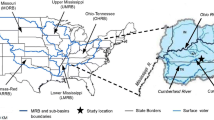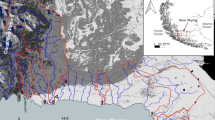Abstract
Organic and inorganic carbon (C) fluxes transported by water were evaluated for dominant hydrologic flowpaths on two adjacent headwater catchments in the Brazilian Amazon with distinct soils and hydrologic responses from September 2003 through April 2005. The Ultisol-dominated catchment produced 30% greater volume of storm-related quickflow (overland flow and shallow subsurface flow) compared to the Oxisol-dominated catchment. Quickflow fluxes were equivalent to 3.2 ± 0.2% of event precipitation for the Ultisol catchment, compared to 2.5 ± 0.3% for the Oxisol-dominated watershed (mean response ±1 SE, n = 27 storms for each watershed). Hydrologic responses were also faster on the Ultisol watershed, with time to peak flow occurring 10 min earlier on average as compared to the runoff response on the Oxisol watershed. These different hydrologic responses are attributed primarily to large differences in saturated hydraulic conductivity (K s). Overland flow was found to be an important feature on both watersheds. This was evidenced by the response rates of overland flow detectors (OFDs) during the rainy season, with overland flow intercepted by 54 ± 0.5% and 65 ± 0.5% of OFDs for the Oxisol and Ultisol watersheds respectively during biweekly periods. Small volumes of quickflow correspond to large fluxes of dissolved organic C (DOC); DOC concentrations of the hydrologic flowpaths that comprise quickflow are an order of magnitude higher than groundwater flowpaths fueling base flow (19.6 ± 1.7 mg l−1 DOC for overland flow and 8.8 ± 0.7 mg l−1 DOC for shallow subsurface flow versus 0.50 ± 0.04,mg l−1 DOC in emergent groundwater). Concentrations of dissolved inorganic C (DIC, as dissolved CO2–C plus HCO −3 –C) in groundwater were found to be an order of magnitude greater than quickflow DIC concentrations (21.5 mg l−1 DIC in emergent groundwater versus 1.1 mg l−1 DIC in overland flow). The importance of deeper flowpaths in the transport of inorganic C to streams is indicated by the 40:1 ratio of DIC:DOC for emergent groundwater. Dissolved CO2–C represented 92% of DIC in emergent groundwater. Results from this study illustrate a highly dynamic and tightly coupled linkage between the C cycle and the hydrologic cycle for both Ultisol and Oxisol landscapes: organic C fluxes strongly tied to flowpaths associated with quickflow, and inorganic C (particularly dissolved CO2) transported via deeper flowpaths.
Similar content being viewed by others
References
Billett MF, Palmer SM, Hope D, Deacon C, Storeton-West R, Hargreaves KJ, Flechard C, Fowler D (2004) Linking land-atmosphere-stream carbon fluxes in a lowland peatland system. Global Biogeochem Cycles 18:1–12
Butler J (1982) Carbon dioxide equilibria and their applications. Addison-Wesley, Reading, Mass
Caron F, Manni G, Workman WJG (1998) A large-scale laboratory experiment to determine the mass transfer of CO2 from a sandy soil to moving groundwater. J␣Geochem Exploration 64:111–125
Chappell N, Franks S, Larenus J (1998) Multi-scale permeability estimation for a tropical catchment. Hydrol Process 12:1507–1523
Davidson EA, Trumbore SE (1995) Gas diffusivity and production of CO2 in deep soils of the eastern Amazon. Tellus Ser B-Chem Phys Meteorol 47:550–565
Elsenbeer H (2001) Hydrologic flowpaths in tropical rainforest soilscapes - a review. Hydrol Process 15:1751–1759
Elsenbeer H, Newton BE, Dunne T, de Moraes JM (1999) Soil hydraulic conductivities of latosols under pasture, forest and teak in Rondonia, Brazil. Hydrol Process 13:1417–1422
Elsenbeer H, Vertessy RA (2000) Stormflow generation and flowpath characteristics in an Amazonian rainforest catchment. Hydrol Process 14:2367–2381
FAO-UNESCO (1987) Soils of the World. Elsevier Science Publishing Co. Inc, New York
Finlay JC (2003) Controls of streamwater dissolved inorganic carbon dynamics in a forested watershed. Biogeochemistry 62:231–252
Gao B, Walter MT, Steenhuis TS, Parlange JY, Richards BK, Hogarth WL, Rose CW, Sander G (2005) Investigating raindrop effects on the transport of sediment and non-sorbed chemicals from soil to surface runoff. J Hydrol 308: 313–320
Godsey S, Elsenbeer H (2002) The soil hydrologic response to forest regrowth: a case study from southwestern Amazonia. Hydrol Process 16:1519–1522
Godsey S, Elsenbeer H, Stallard R (2004) Overland flow generation in two lithologically distinct rainforest catchments. J Hydrol 295:276–290
Gomi T, Sidle RC, Richardson JS (2002) Understanding processes and downstream linkages of headwater systems. BioScience 52:905–916
Hewlett JD, Hibbert AR (1967) Factors affecting the response of small watersheds to precipitation in humid areas. In: Sopper WE, Lull HW (eds) International symposium on forest hydrology. Pergamon Press, New York
Hope D, Palmer SM, Billett MF, Dawson JJC (2004) Variations in dissolved CO2 and CH4 in a first-order stream and catchment: an investigation of soil–stream linkages. Hydrol Process 18:3255–3275
Jassal RS, Black TA, Drewitt GB, Novak MD, Gaumont-Guay D, Nesic Z (2004) A model of the production and transport of CO2 in soil: predicting soil CO2 concentrations and CO2 efflux from a forest floor. Agric Forest Meteorol 124:219–236
Jones JB, Mulholland PJ (1998) Carbon dioxide variation in a hardwood forest stream: an integrative measure of whole catchment soil respiration. Ecosystems 1:183–196
Kalbitz K, Schwesig D, Schmerwitz J, Kaiser K, Haumaier L, Glaser B, Ellerbrock R, Leinweber P (2003) Changes in properties of soil-derived dissolved organic matter induced by biodegradation. Soil Biol Biochem 35:1129–1142
Kirkby M, Callan J, Weyman D, Wood J (1976) Measurement and modeling of dynamic contributing areas in very small catchments, Working Paper No. 167. School of Geography University of Leeds, Leeds
Lesack LFW (1993) Water balance and hydrologic characteristics of a rain forest catchment in central Amazon Basin. Water Resour Res 29:759–773
Mackereth F, Heron J, Talling J (1978) Water analysis: some revised methods for Limnologists. Freshwater Biological Association, Ambleside, UK
Mayorga E, Aufdenkampe AK, Masiello CA, Krusche AV, Hedges JI, Quay PD, Richey JE (2005) Young organic matter as a source of carbon dioxide outgassing from Amazonian rivers. Nature 436:538–541
McClain ME, Elsenbeer H (2001) Terrestrial inputs to Amazon streams and internal biogeochemical processing. In: McClain ME, Victoria RL, Richey JE (eds) The biogeochemistry of the Amazon Basin. Oxford University Press, Oxford, pp 185–208
McDonnell JJ (2003) Where does water go when it rains? Moving beyond the variable source area concept of rainfall-runoff response. Hydrol Process 17:1869–1875
Ministry of Mines and Energy (Brazil) (1980) Projeto RADAMBRASIL. Folha SC. 21 - Juruena, Levantamento de Recursos Naturais, 20, Rio de Janeiro
National Research Council (2004) Groundwater fluxes across interfaces. National Academies Press, Washington, DC
Neal C (2001) Alkalinity measurements within natural waters: towards a standardised approach. Sci Total Environ 265:99–113
Novães Filho JP (2005) Variabilidade espacial de atributos de solo em microbacias sob vegetação de floresta na Amazônia meridional. Universidade Federal de Mato Grosso, Cuiabá, Brazil, 120 pp
Nunes PC (2003) Influência do efluxo de CO2 do solo na produção de forragem numa pastagem extensiva e num sistema agrosilvipastoril. MSc. Thesis, Universidade Federal de Mato Grosso, Cuiabá, 67 pp.
Palmer SM, Hope D, Billett MF, Dawson JJC, Bryant CL (2001) Sources of organic and inorganic carbon in a headwater stream: Evidence from carbon isotope studies. Biogeochemistry 52:321–338
Qualls RG, Haines BL, Swank WT, Tyler SW (2002) Retention of soluble organic nutrients by a forested ecosystem. Biogeochemistry 61:135–171
Richey JE, Melack JM, Aufdenkampe AK, Ballester VM, Hess LL (2002) Outgassing from Amazonian rivers and wetlands as a large tropical source of atmospheric CO2. Nature 416:617–620
Robinson JS, Sivapalan M, Snell JD (1995) On the relative roles of hillslope processes, channel routing, and network geomorphology in the hydrological response of natural catchments. Water Resour Res 31:3089–3101
Saxton K (2005) Soil water characteristic estimates by texture and organic matter for hydrologic solutions. USDA Agricultural Research Service, Pullman, Washington
Schwesig D, Kalbitz K, Matzner E (2003) Mineralization of dissolved organic carbon in mineral soil solution of two forest soils. J Plant Nutr Soil Sci 166:585–593
Siemens J (2003) The European carbon budget: a gap. Science 302:1681–1681
Soil Survey Staff (1999) Soil taxonomy: a basic system of soil classification for making and interpreting soil surveys. Agriculture Handbook # 436, USDA Natural Resource Conservation Service, Washington, DC
Stumm W, Morgan JJ (1981) Aquatic chemistry. John Wiley & Sons, New York
Tang J, Baldocchi DD, Qi Y, Xu L (2003) Assessing soil CO2 efflux using continuous measurements of CO2 profiles in soils with small solid-state sensors. Agric Forest Meteorol 118:207–220
Turpin HW (1920) The carbon dioxide of the soil air. Cornell Univ Agric Exp Station Memoir 32:319–362
Walter MT, Gerard-Marchant P, Steenhuis TS, Walter MF (2005) Closure to “Simple Estimation of Prevalence of Hortonian Flow in New York City Watersheds” by M. Todd Walter, Vishal K. Mehta, Alexis M. Marrone, Jan Boll, Pierre Gérard-Marchant, Tammo S. Steenhuis, and Michael F. Walter. J Hydrol Eng 10:169–170
Wilks DS (1995) Statistical methods in the atmospheric sciences. Academic Press, San Diego
Zech W, Senesi N, Guggenberger G, Kaiser K, Lehmann J, Miano TM, Miltner A, Schroth G (1997) Factors controlling humifaction and mineralization of soil organic matter in the tropics. Geoderma 79:117–161
Zhang H (1997) Determination of soil sorptivity and hydraulic conductivity from the disk infiltrometer. Soil Sci Soc Am J 61:1024–1030
Acknowledgements
The study was supported by NASA LBA-ECO grant to project group ND-11 and research grants from the Cornell University Program on Biogeochemistry and Center for the Environment to MSJ. The authors greatly appreciate the collaborations of field site hosts Rohden Indústria Lígnea Ltda. and Apolinário Stuhler. We thank Jeffrey Richey, Alex Krusche and Paulo Nunes for conceptual and logistical support, Mara Abdo for laboratory assistance, and Benedito Silveira de Andrade and Elielton Anterio da Souza for field assistance. Comments received from Todd Walter, Vishal Mehta and the anonymous reviewers were very helpful in the preparation of the manuscript.
Author information
Authors and Affiliations
Corresponding author
Rights and permissions
About this article
Cite this article
Johnson, M.S., Lehmann, J., Couto, E.G. et al. DOC and DIC in Flowpaths of Amazonian Headwater Catchments with Hydrologically Contrasting Soils. Biogeochemistry 81, 45–57 (2006). https://doi.org/10.1007/s10533-006-9029-3
Received:
Accepted:
Published:
Issue Date:
DOI: https://doi.org/10.1007/s10533-006-9029-3




